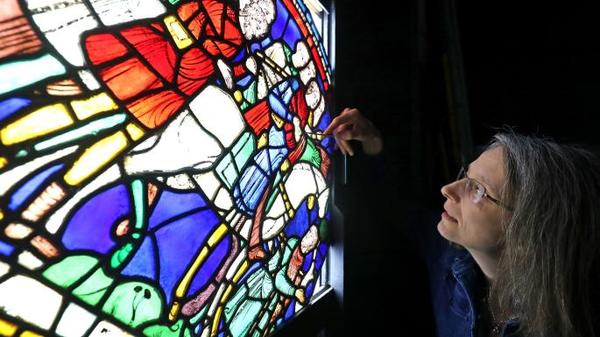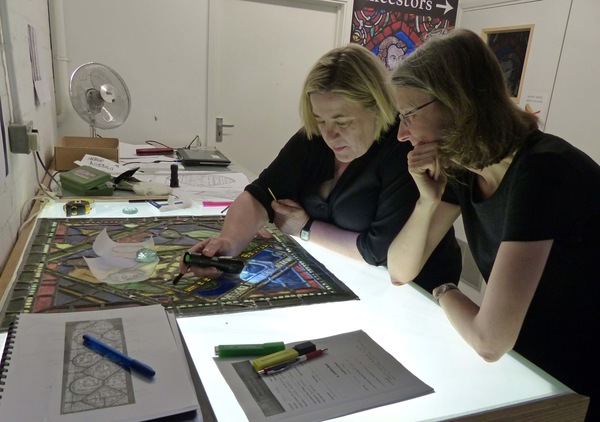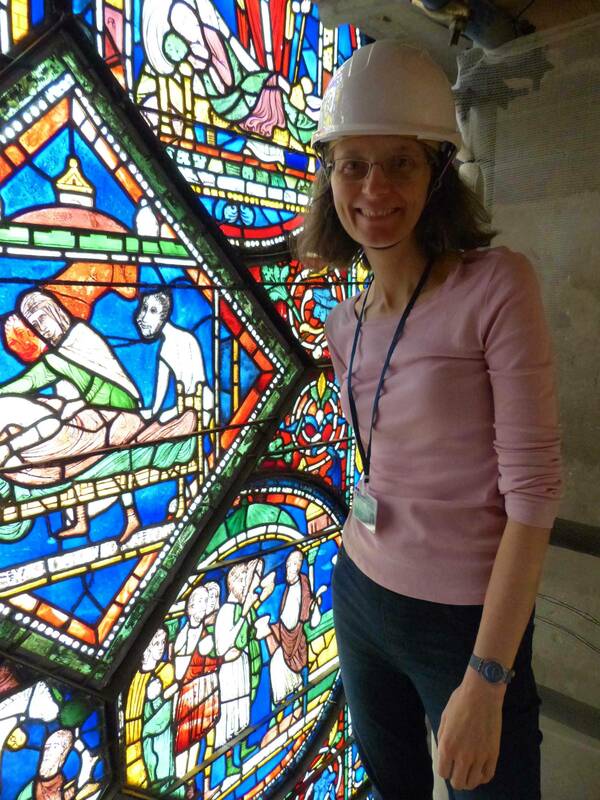"Interdisciplinary Training Works": Rachel Koopmans (Ph.D. '01) Combines Art, History, and Literature in Her Lecture on Canterbury Cathedral Stained Glass Renovation
Rachel Koopmans (Ph.D. '01), now Associate Professor of History at the University of York, returned to campus on Thursday, March 17, 2022, for the final lecture in the 75th Anniversary Alumni Lecture Series. In "Reading, Restoring, and Rearranging a ‘Miracle Window’ of Canterbury Cathedral," Koopmans described the conservation process of North Three (NIII), a towering six-meter window in Canterbury Cathedral with glass dating to the 12th and 13th centuries. Over the past 800 years, the window's sixty-eight panels have experienced intrigue and confusion as glass was lost, replaced, and misplaced, giving the lecture the distinct and exciting air of a detective story.

Koopmans' interest in Canterbury Cathedral's stained glass developed out of her dissertation at Notre Dame, which introduced her to the miracle stories of Archbishop Thomas Becket. As someone familiar with the stories collected in Benedict of Peterborough's Passion and Miracles of Saint Thomas of Canterbury (1171–3), Koopmans noticed something strange when she saw the Becket windows. The description of one window identified one figure as an Augustinian prior, but she recognized the story from her reading: it was not about a prior at all, but a local knight.
Many of the panels at Canterbury, Koopmans hypothesized, might be similarly misattributed. Like a manuscript, the order in a stained-glass window can become muddled over time. Just as a scribe might reorganize a text, make additions, or remove words or paragraphs, the images in stained glass change as pieces are lost, the lead joining the glass pieces is replaced, and entire panels shift locations.

In 2018, Koopmans teamed up with Léonie Seliger, the stained-glass conservator at Canterbury Cathedral, to reorganize and restore a smaller window in the cathedral. Then, in 2020, the two had their big break: NIII was removed for display at a Thomas Becket exhibit at the British Museum, allowing the two to examine the glass outside of its cathedral context.
By looking at the panels on a light table, the two were able to identify the changes that occurred during several phases of comparatively recent restoration. In 1857, George Austin replaced the entire window's lead; during this process, he filled gaps in NIII with four entirely new panels, and replaced fractured glass with a mix of hand-painted works and medieval glass from elsewhere. In the early 1900s, Samuel Caldwell, Jr., one long-time caretaker of the Canterbury windows, illegally sold glass from the windows and added fraudulent sections without proper notation, even moving one medieval miter (a bishop's hat) from NIII to a different panel.

Thanks to Koopmans' and Seliger's careful study and historical sleuthing, this stained-glass miter will be restored to its rightful body, clarifying the narrative portrayed in the panel. In addition, several panels will be moved this fall so that medieval glass is more visible to the public. Finally, Koopmans and Seliger have corrected readings of the rhyming Latin hexameter inscriptions on several panels using a process Koopmans described as "medieval Wordle." All of this work will make it easier for Canterbury visitors to understand and enjoy the medieval windows. Long-term, Koopmans and Seliger hope to also update the Corpus Vitrearum Medii Aevi entry on the Miracle Windows to reflect their findings.
Koopmans argued that this work would not be possible without the broad and rigorous training she received at the Medieval Institute, which taught her to follow where the sources take her, even across disciplinary boundaries. As she remarked, "interdisciplinary training works."
Learn more about Dr. Koopmans' work at Canterbury Cathedral by reading her Alumni Spotlight. The MI has also written about her re-dating of one of the medieval Becket panels, previously thought to be Victorian.
This was the third and final lecture in the MI’s 75th anniversary alumni lecture series. Professor Leslie Lockett (Ph.D. '04) visited the MI in September to talk about her work on Augustine’s Soliloquia, and Professor Irving (Ph.D. '12) presented his work on the liturgical uses of the Uta Codex in February. The MI has been proud to showcase the excellent work of its alumni, who make this anniversary possible.